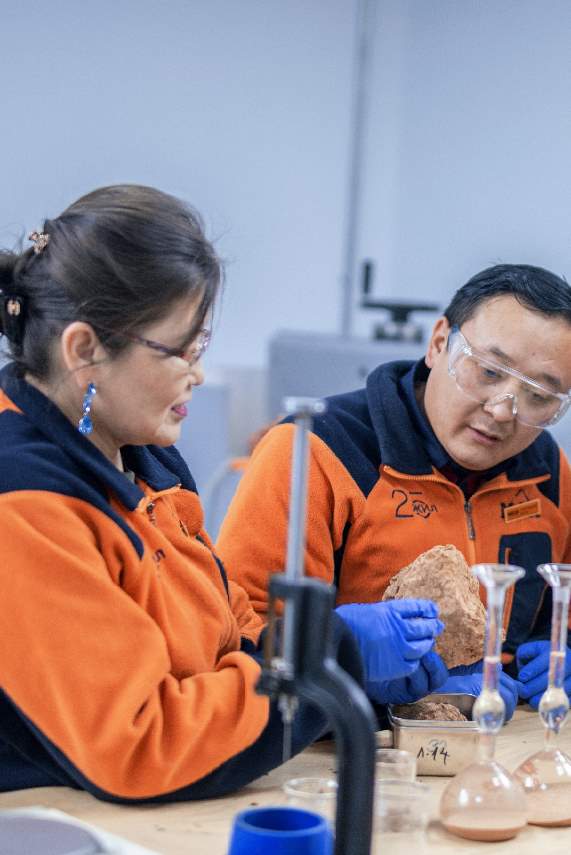Construction materials research laboratory

“True TRC” LLC’s “Construction Materials Research Laboratory” is engaged in the following activities.
Construction materials study, testing and quality control/quality assurance
- All types of analysis of raw materials (sand, gravel, crushed stone, clay, cement) used in construction work
- Determination of concrete content (heavy and aerated concrete)
- Daily and frequency quality control of samples taken from concrete pours of buildings and structures
- Combination of concrete batching plant technology
Road materials study and testing
- Analysis and frequency analysis of road and railway quarries, dams and paving materials (gravel, crushed stone, sand, mineral powder, cement, bitumen)
- Determination of embankment structure (crushed stone foundation, cement-reinforced foundation, asphalt concrete, cement concrete)
- Concrete, concrete structures, sand, gravel, crushed stone, cement analysis and input for bridges, pipes and drainage systems
Laboratory analysis of construction materials
| № |
Type of test |
Indicators |
Sample size |
| Sample preparation |
| 5.0 |
Crush, mix and divide by an average of 3 mm |
|
10 kg |
| Grinding (3.35 mm) |
|
1кg |
| Sample drying |
|
up to 5 kg |
| Sample drying |
|
5 kgover |
| The sample is bagged and packaged |
|
10 kg |
| The sample is bagged and packaged |
|
30 kg |
| The sample is bagged and packaged |
|
50 kg |
| Moisture |
|
1кg |
| Sort through a sieve |
|
30кg |
| Cement |
| 5.1 |
Physic -mechanic / x / |
5 |
15-20 kg |
| Physic-mechanic / s / |
5 |
15-20 kg |
| Cold tolerance |
6 |
15-20 kg |
| Volume change |
1 |
10 kg |
| Degree of grinding |
1 |
1 kg |
| Сementconcrete admixture |
| 5.2 |
Physic-mechanic / s / |
5 |
15-20 kg |
| Cold tolerance |
6 |
1 kg |
| Volume weight |
1 |
10 kg |
| Volume change |
1 |
10 kg |
| determine the composition of concrete |
2 |
10 kg |
| Lime |
| 5.3 |
Physic-mechanic |
5 |
15 kg |
| undissolved residue |
1 |
5 kg |
| Gypsum |
| 5.4 |
Physic-mechanic |
5 |
15 kg |
| Construction materials and minerals |
| 5.5 |
XRF |
|
1 kg |
| Renten (RFA) interpretation |
|
|
| X-ray quantitative analysis |
|
1 kg |
| X-ray quantitative analysis / interpretation |
|
|
| Thermal analysis (DTA) interpretation |
|
1 kg |
| Sand |
| 5.6 |
Granulometer composition |
1 |
15-20 kg |
| Identify the module |
1 |
| Moisture |
1 |
| Water absorption |
1 |
| Space between pieces |
1 |
| Filling density |
1 |
| Clay mixture |
1 |
| Dense |
1 |
| Organic mixture |
1 |
| Cold tolerance |
1 |
|
| Gravel, crushed stone,sand |
| 5.7 |
Physicist-mechanic |
|
15-20 kg |
| Reactivity |
|
| Crushing |
|
| Depreciation |
|
| Cold tolerance |
|
| UV spectrometer to measure light transmission |
|
| Vacuum factor |
|
| Clay |
| 5.8 |
Physicist-mechanic |
|
15-20 kg |
| Flexible |
|
| Reactivity |
|
| Lightweight filler |
| 5.9 |
Physics-Mechanic |
5 |
25-30 kg |
| Brick |
| 5.10 |
Strength |
1 |
15-20 kg |
| Technology testing |
| 5.11 |
Extraction of clinker |
|
|
| Grinding in a ball mill |
|
25 kg |
| Production of cement clinker at 14500C |
|
10 kg |
| Extraction of cement |
|
|
| Grinding in a ball mill |
|
25 kg |
| Experiments to determine the physic-mechanical properties |
|
25 kg |
| Extraction of lime |
|
|
| Testing of lime production technology |
1 |
10 kg |
| Determination of lime quality and physic-mechanical properties |
4 |
10 kg |
| Determine the direction of use of gravel, sand and glay |
| 5.12 |
Determination of physical and mechanical properties of the obtained material |
4 |
10 kg |
| Reporting |

 True TRC
True TRC